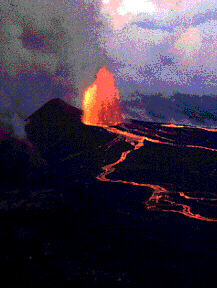This is an image of Mauna Kea erupting.
Click on image for full size
Image from: U.S. Geological Survey
Shield Volcanoes
Shield volcanoes can grow to be very big. In fact, the oldest continental regions of Earth may be the remains of ancient shield volcanoes.
Unlike the composite volcanoes which are tall and thin, shield volcanoes are tall and broad, with flat, rounded shapes. The Hawaiian volcanoes exemplify the common type of shield volcano. They are built by countless outpourings of lava that advance great distances from a central summit vent or group of vents. The outpourings of lava are typically not accompanied by pyroclastic material, which make the shield volcanoes relatively safe, as shown in this picture of scientists monitoring the eruption.
Mauna Loa, the largest of the shield volcanoes, is 13,677 feet above sea level, which means it rises over 28,000 feet above the deep ocean floor, and would be the worlds tallest mountain if much of it were not underwater.
Famous shield volcanoes include Mauna Loa, Kilauea, (two of the world's most active volcanoes), andOlympus Mons of Mars.
You might also be interested in:
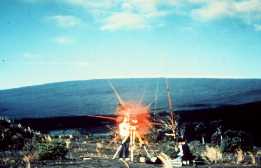
This image shows volcanologists monitoring the changing shape of a shield volcano with laser surveying instruments. volcanologists also use remote sensing and other tools to measure volcanoes.
...more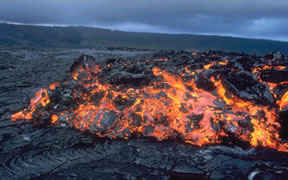
Basalt is a hard, black extrusive igneous rock. It is the most common type of rock in the Earth's crust and it makes up most of the ocean floor. The prevalence of dark minerals such as pyroxene and olivine
...more
Ash is made of millions of tiny fragments of rock and glass formed during a volcanic eruption. Volcanic ash particles are less than 2 mm in size and can be much smaller. Volcanic ash forms in several ways
...more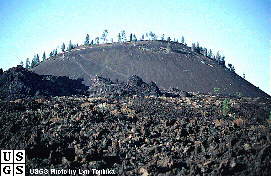
Cinder cones are simple volcanoes which have a bowl-shaped crater at the summit and rarely rise more than a thousand feet above their surroundings. They usually are created of eruptions from a single vent,
...more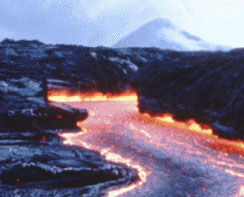
Lava can move in broad flat lava flows, or it can move through constrictive channels or tubes. Lava flows have a large surface area so they tend to cool quickly and flow slowly. The fastest unconstricted
...more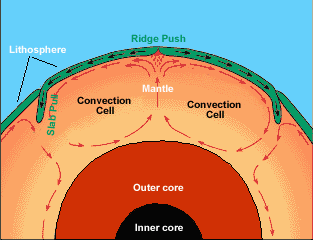
Earth’s center, or core, is very hot, about 9000 degrees F. This heat causes molten rock deep within the mantle layer to move. Warm material rises, cools, and eventually sinks down. As the cool material
...more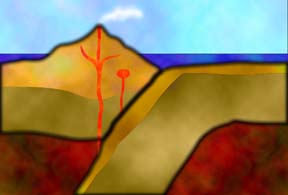
Many kinds of surface features provide evidence of a sliding lithosphere. When two plates move apart, rising material from the mantle pushes the lithosphere aside. Two types of features can form when
...more


